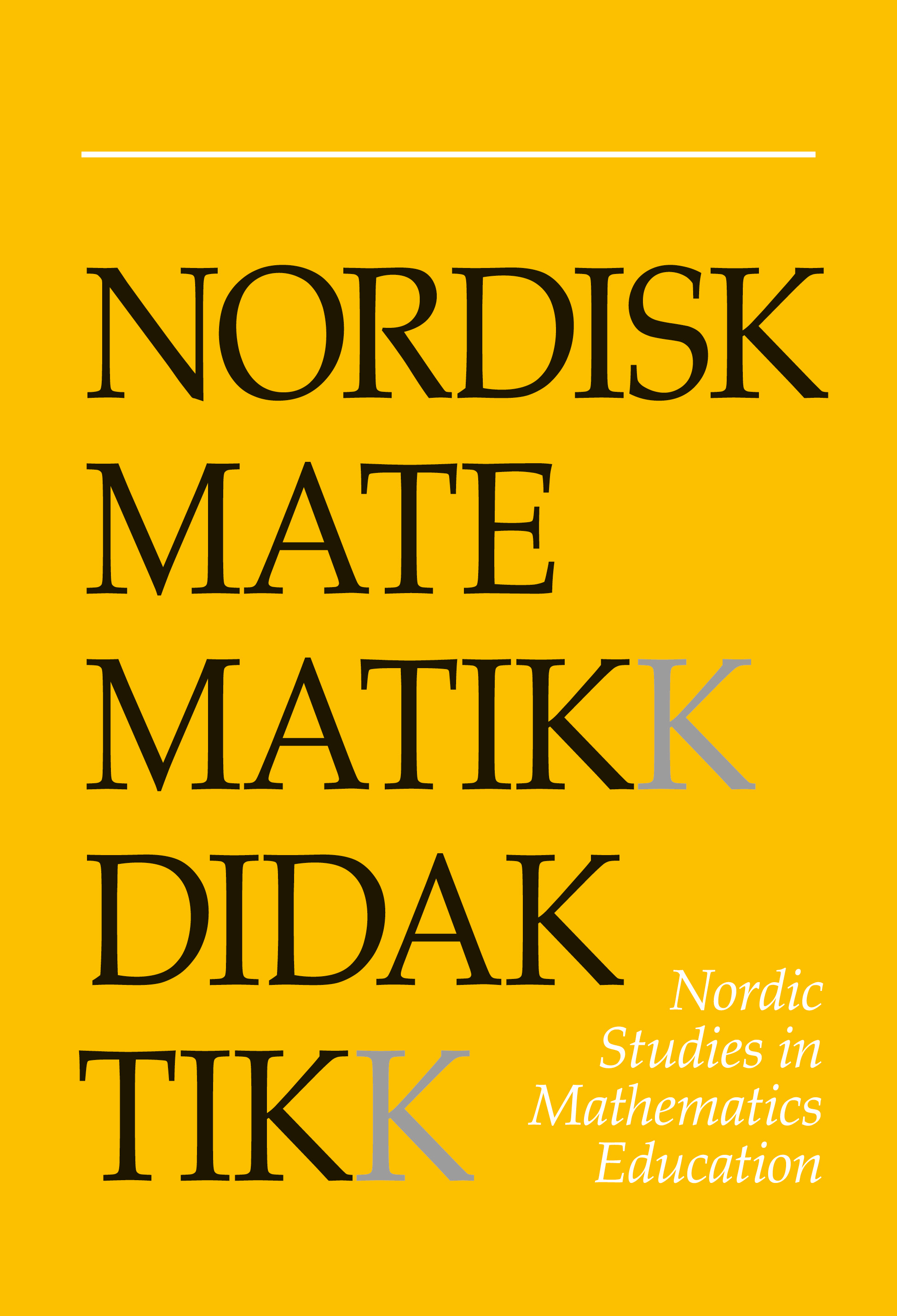Investigating the development of number sense in a 6th grade class in Taiwan
DOI:
https://doi.org/10.7146/nomad.v10i1.147157Abstract
This research study reports snapshots of a 6th grade Taiwanese class depicting how a teacher investigated and promoted his students’ development of number sense. It illustrates students' tendency to rely on written algorithms and reveals some misconceptions that may exist among students that are generally proficient in written computation. It demonstrates an effort to integrate number sense activities into the mathematics class in ways that encourage exploration, discussion, thinking, and reasoning.
References
Beaton, A. E. , Mullis, L., Martin, M. O., Gonzalez, E. J., Kelly, D. L. et al. (1997). Mathematics achievement in the middle school years, IEA's third international mathematics and science study. Chestnut Hill, MA:Boston College, Center for the Study of Testing, Evaluation and Educational Policy.
Burton, G. (1993). Number sense and operations. Reston, VA: NCTM.
Cobb, P., Wood, T., Yackel, E., Nicholls, J. Wheatly, G. et al. (1991). Assessment of a problem-centered second-grade mathematics project. Journal for Research in Mathematics Education, 220, 3-29. https://doi.org/10.2307/749551
Gonzales, P., Calsyn, C., Jocelyn, L., Mak, K. Kastberg, D. et al. (2000). Pursuing excellence: Comparison of international eighth-grade mathematics and science achievement from a U.S. perspective, 1995 and 1999. Washington, DC: National Center for Educational Statistics.
Greeno, J. G. (1991). Number sense as situated knowing in a conceptual domain. Journal for Research in Mathematics Education, 22 (3), 170-218. https://doi.org/10.2307/749074
Howden, H. (1989). Teaching number sense. Arithmetic Teacher, 36 (6), 6-11. https://doi.org/10.5951/AT.36.6.0006
Markovits, Z. & Sowder J. T. (1994). Developing number sense: An intervention study in grade 7. Journal for Research in Mathematics Education, 25 (l), 4-29. https://doi.org/10.2307/749290
Martin, M.O., Mullis, I.V.S. and Chrostowski, S.J. (2004). TIMSS 2003 Technical report: Findings from IEA's Trends in International Mathematics and Science Study at the eighth and fourth grades. Chestnut Hill, MA: Boston College.
McIntosh, A., Reys, B. J., & Reys, R. E. (1992). A proposed framework for examining basic number sense. For the Learning of Mathematics, 12 (3), 2-8.
McIntosh, A., Reys, B., & Reys, R. (1997a). Simple Effective Number Sense Experiences (SENSE), Grades 1-2, 3-4, & 6-8. Palo Alto, CA: Dale Seymour Publications.
McIntosh, A., Reys, B., Reys, R. & Hope, J. (1997b). Simple Effective Number Sense Experiences (SENSE), grades 4-6. Palo Alto, CA: Dale Seymour Publications.
National Council of Teachers of Mathematics. (1989). Curriculum and evaluation standards for school mathematics. Reston, VA: NCTM.
National Council of Teachers of Mathematics. (2000). Principles and standards for school mathematics. Reston, VA: NCTM.
National Research Council. (1989). Everybody counts. A report to the nation on the future of mathematics education. Washington, DC: National Academy Press.
Resnick, L.B.(1989). Defining, assessing and teaching number sense. In Sowder & Schappelle (Eds.), Establishing foundations for research on number sense and related topics: Report of a conference. San Diego State University, Center for Research in Mathematics and Science Education.
Reys, B. J., Barger, R., Dougherty, B., Hope, J., Markovits, Z. et al. (1991). Developing number sense in the middle grades. Reston, VA: NCTM.
Reys, R. E., Reys, B. J., McIntosh, A., Emanuelsson, G., Johansson, B. et al. (1999). Assessing number sense of students in Australia, Sweden, Taiwan and the United States. School Science and Mathematics, 99 (2), 61-70. https://doi.org/10.1111/j.1949-8594.1999.tb17449.x
Reys, R. E. & Yang, D. C. (1998). Relationship between computational performance and number sense among sixth- and eighth-grade students in Taiwan. Journal for Research in Mathematics Education, 29 (2), 225-237. https://doi.org/10.2307/749900
Sowder, J. (1992a). Estimation and number sense. In D. A. Grouws (Ed.), Handbook of research on mathematics teaching and learning (pp.371-389). New York: Macmillan
Sowder, J. (1992b). Making sense of numbers in school mathematics. In G. Leinhardt, R. & R. Hattrup (Eds.), Analysis of arithmetic for mathematics teaching (pp. 1-51). Hillsdale, NJ: Lawrence Erlbaum. https://doi.org/10.4324/9781315044606-1
Sowder, J. T. & Schappelle, B. P. (Eds.) (1989). Establishing foundations for research on number sense and related topics: Report of a conference. San Diego State University, Center for Research in Mathematics and Science Education.
Stevenson, H. W., Chen, C., & Lee, S. Y. (1993). Mathematical achievement of Chinese, Japanese, & American children: Ten years later. Science, 259, 53-58. https://doi.org/10.1126/science.8418494
Stevenson, H. W., Lee, S. Y., & Stigler, J. W. (1986). Mathematical achievement of Chinese, Japanese, and American children. Science, 231, 693-99. https://doi.org/10.1126/science.3945803
Stigler, J. W., Lee, S. Y., & Stevenson, H. W. (1991). Mathematical knowledge of Japanese, Chinese, and American elementary school children. Reston, VA: NCTM.
Thornton, C. A., & Tucker, S. C. (1989). Lesson planning: The key to developing number sense. Arithmetic Teacher, 36 (2), 18-21. https://doi.org/10.5951/AT.36.6.0018
Treffers, A. (1991). Meeting innumeracy at primary school. Educational Studies in Mathematics, 26 (l), 333-352. https://doi.org/10.1007/BF00369294
Warrington, M. A. & Kamii, C. (1998). Multiplication with fractions: A piagetian, constructivist approach. Mathematics Teaching in the Middle School, 3 (5), 339-343. https://doi.org/10.5951/MTMS.3.5.0339
Downloads
Published
How to Cite
Issue
Section
License

This work is licensed under a Creative Commons Attribution-NonCommercial-ShareAlike 4.0 International License.



